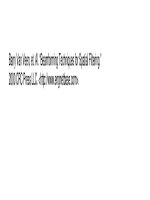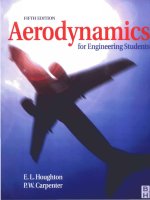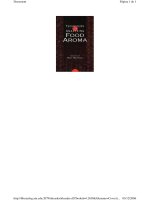Techniques for Engineering Decisions Simulation
Bạn đang xem bản rút gọn của tài liệu. Xem và tải ngay bản đầy đủ của tài liệu tại đây (78.48 KB, 28 trang )
ECE 307 – Techniques for Engineering
Decisions
Simulation
George Gross
Department of Electrical and Computer Engineering
University of Illinois at Urbana-Champaign
© 2006 – 2009 George Gross, University of Illinois at Urbana-Champaign, All Rights Reserved.
1
SIMULATION
Simulation provides a systematic approach for
dealing with uncertainty by “flipping a coin” to deal
with each uncertain event
In many real world situations, simulation may be
the only viable means to quantitatively deal with a
problem under uncertainty
Effective simulation requires implementation of
appropriate approximations at many and, sometimes, at possibly every stage of the problem
© 2006 – 2009 George Gross, University of Illinois at Urbana-Champaign, All Rights Reserved.
2
SIMULATION EXAMPLE
The problem is concerned with the fabric purchase
by a fashion designer
The two choices for textile suppliers are:
supplier 1: fixed price – constant 2 $/yd
supplier 2: variable price dependent on quantity
2.10 $/yd for the first 20,000 yd 1.90 $/yd
for the next 10,000 yd 1.70 $/yd for the
next 10,000 yd 1.50 $/yd thereafter
© 2006 – 2009 George Gross, University of Illinois at Urbana-Champaign, All Rights Reserved.
3
SIMULATION EXAMPLE
The purchaser is uncertain about the demand D
but determines an appropriate model is:
D ~ N (25,000 yd ,5,000 yd )
The decision may be represented in form of the
following decision branches:
© 2006 – 2009 George Gross, University of Illinois at Urbana-Champaign, All Rights Reserved.
4
su
pp
lie
r1
SIMULATION EXAMPLE
i
i D
i
C = 2⋅ D
D ≤ 20,000 C = 2.1D
sup
20,000 < D ≤ 30,000 C = 1.9( D − 20,000) + 42,000
r
plie
2
30,000 < D ≤ 40,000 C = 1.7( D − 30,000) + 61,000
D > 40,000 C = 1.5( D − 40,000) + 78,000
© 2006 – 2009 George Gross, University of Illinois at Urbana-Champaign, All Rights Reserved.
5
SIMULATION EXAMPLE
Supplier 1 has a simple linear cost function C
Supplier 2 has a far more complicated scheme to
evaluate costs: in effect, the range of the
demand and the corresponding probability for D
to be in a part of the range must be known, as
well as the expected value of D for each range
© 2006 – 2009 George Gross, University of Illinois at Urbana-Champaign, All Rights Reserved.
6
SIMULATION EXAMPLE
We simulate the situation in the decision tree by
“drawing multiple samples from the appropriate
population”
We systematically tabulate the results and
evaluate the required statistics
The simple algorithm for the simulation consists
of just a few steps which are repeated until an
appropriate sized sample is obtained
© 2006 – 2009 George Gross, University of Illinois at Urbana-Champaign, All Rights Reserved.
7
BASIC ALGORITHM
Step 0 : store the distribution N
( 25,000,
5,000 ) ;
determine k , the maximum number of
draws; set k = 0
Step 1 : if k > k , stop; else set k = k + 1
Step 2 : draw a random sample from the normal
distribution N
( 25,000,
5,000 )
Step 3 : evaluate the outcomes on both branches;
enter each outcome into the database and
return to Step 1
© 2006 – 2009 George Gross, University of Illinois at Urbana-Champaign, All Rights Reserved.
8
SIMULATION EXAMPLE
Application of the algorithm allows the determi–
nation of the histogram of the cost figures and
then the evaluation of the expected costs
For the assumed demand, for supplier 1, we have
the straight forward case of
E {C } = 2 ⋅ E { D} = 50,000 and σ C = 10,000
and the use of the algorithm may be bypassed
For the supplier 2, the algorithm is applied for the
random k draws
© 2006 – 2009 George Gross, University of Illinois at Urbana-Champaign, All Rights Reserved.
9
RANDOM DRAWS
A key issue is the generation of random draws for
which we need a random number generator
One possibility is to use a uniformly distributed
r.v. between 0 and 1
1.0
probability
⎧ x ∈ [0,1] with probability 1
X = x⎨
⎩ x ∉ [0,1] with probability 0
0
1
© 2006 – 2009 George Gross, University of Illinois at Urbana-Champaign, All Rights Reserved.
10
SIMULATION EXAMPLE
We draw a random value of x , say x *, and work
*
y
of the
through the c.d.f. FY ( y ) to get the value
( )
r.v. Y with FY y * = x *
probability
1.0
FY ( y ) = P {Y ≤ y }
x*
0
y*
y
© 2006 – 2009 George Gross, University of Illinois at Urbana-Champaign, All Rights Reserved.
11
SOFT PRETZEL EXAMPLE
The market size is unknown but we assume that
the market size is a normal with
S ~ N ( 100,000 , 10,000 )
We are interested in determining the fraction F of
the new market the new company can capture
We model the distribution of F with a discrete
distribution
© 2006 – 2009 George Gross, University of Illinois at Urbana-Champaign, All Rights Reserved.
12
SOFT PRETZEL EXAMPLE
F = x%
P {F = x}
16
0.15
19
0.35
25
0.35
28
0.15
© 2006 – 2009 George Gross, University of Illinois at Urbana-Champaign, All Rights Reserved.
13
SOFT PRETZEL EXAMPLE
Sales price of a pretzel is $ 0.50
Variable costs V are represented by a uniformly
distributed r.v. in the range [0.08 , 0.12] $/pretzel
Fixed costs C are also random
The contributions to profits are given by
π = ( S ⋅ F ) ⋅ (0.5 − V ) − C
and may be evaluated via simulation
© 2006 – 2009 George Gross, University of Illinois at Urbana-Champaign, All Rights Reserved.
14
MANUFACTURING CASE STUDY
The selection of one of two manufacturing
processes based on net present value (NPV) using
a 3 – year horizon (current year plus next two
years) and a 10% discount rate
The process is used to manufacture a product sold
at 8 $/unit
© 2006 – 2009 George Gross, University of Illinois at Urbana-Champaign, All Rights Reserved.
15
PROCESS 1 DESCRIPTION
This process uses the current machinery for
manufacturing
The annual fixed costs are $ 12,000
The yearly variable costs are represented by the
r.v.
Vi ~
N ( 4, 0.4 )
i = 0 ,1, 2
© 2006 – 2009 George Gross, University of Illinois at Urbana-Champaign, All Rights Reserved.
16
PROCESS 1 DESCRIPTION
The failure of a machine in the process is random
and the number failures Z i in year i = 0,1, 2 is a
r.v. with
Z i ~ Poisson ( m = 4 )
i = 0 ,1, 2
Each failure incurs costs of $ 8,000
Total costs are the sum of V i and 8, 000 Z i
© 2006 – 2009 George Gross, University of Illinois at Urbana-Champaign, All Rights Reserved.
17
PROCESS 1: UNCERTAINTY IN THE
SALES FORECAST
current year
i = 0
d0
{
P D0
=
next year
i = 1
d0
}
d1
{
P D1
year after
i = 2
=
d1
}
d2
{
P D2
=
11,000
0.2
8,000
0.2
4,000
0.1
16,000
0.6
19,000
0.4
21,000
0.5
21,000
0.2
27,000
0.4
37,000
0.4
© 2006 – 2009 George Gross, University of Illinois at Urbana-Champaign, All Rights Reserved.
d2
}
18
PROCESS 2: DESCRIPTION
Process 2 involves an investment of $ 60,000 paid in
cash to buy new equipment and doing away with
the worthless current machinery; the fixed costs
of $ 12,000 per year remain unchanged
The yearly variable costs V i
Vi ~
N ( $3.50, $1.0 )
i = 0 , 1, 2
The number of machine failures Z i for year
Z i ~ Poisson
( m = 3)
i = 0 , 1, 2
and the costs per failure are $ 6,000
© 2006 – 2009 George Gross, University of Illinois at Urbana-Champaign, All Rights Reserved.
19
PROCESS 2: SALES FORECAST
current year
i = 0
d0
{
P D0
=
next year
i = 1
d0
}
d1
{
P D1
year after
i = 2
=
d1
}
d2
{
P D2
=
14,000
0.3
12,000
0.36
9,000
0.4
19,000
0.4
23,000
0.36
26,000
0.1
24,000
0.3
31,000
0.28
42,000
0.5
© 2006 – 2009 George Gross, University of Illinois at Urbana-Champaign, All Rights Reserved.
d2
}
20
NET PROFITS
The net profits π i each year are a function
(
π i = f D i ,V i , Z i
)
i = 0 , 1, 2
While for each process the determination of Fπ i ( ⋅ )
requires the evaluation of all the possible out-
{ }
{ }
comes; both E π i and var π i may be estimated
by simulation by drawing an appropriate number
of samples from the underlying distribution
© 2006 – 2009 George Gross, University of Illinois at Urbana-Champaign, All Rights Reserved.
21
NPV
The NPV of these profits needs to be assessed
and expressed in terms of year 0 dollars
The profits are collected at the end of each year
or equivalently the beginning of the following year
We use the i = 10% discount factor to express
{ }
the var π i in year 0 (current) dollars
© 2006 – 2009 George Gross, University of Illinois at Urbana-Champaign, All Rights Reserved.
22
NPV
We can evaluate for processes 1 and 2 the profits
for each year; we use superscript to denote the
process
process 1: π
1
i
= 8 D i − D iV i − 8, 000 Z i − 12, 000
i = 0 ,1, 2
process 2: π
2
i
= 8 D i − D iV i − 6, 000 Z i − 12, 000
and we also need to account for the $ 60,000
investment in year 0 for process 2
© 2006 – 2009 George Gross, University of Illinois at Urbana-Champaign, All Rights Reserved.
23
NPV
The NPV evaluation then is stated as the r.v.
Π
2
1
=
∑ π ( 1.1)
1
− ( i + 1)
i
i =0
and
Π
2
2
= − 60, 000 +
∑ π ( 1.1)
2
− ( i + 1)
i
i =0
Simulation is used to evaluate
NPV
1
{ }
= E Π
1
NPV
2
{ }
= E Π
2
© 2006 – 2009 George Gross, University of Illinois at Urbana-Champaign, All Rights Reserved.
24
SIMULATION RESULTS
For a 1,000 replications we obtain
{∑ Π
process j
mean ($)
standard
deviation ($)
1
91,160
46,970
0.029
2
110,150
72,300
0.046
P
© 2006 – 2009 George Gross, University of Illinois at Urbana-Champaign, All Rights Reserved.
j
<0
}
25









